

MABPA: Mexican American Business and Professional Association
Mission
MABPA: Prioritizing access, advocacy and prosperity for all San Diego Communities.
MABPA’s robust membership actualizes its mission with an informed focus on Business, Education, Community Leadership, and the Legislative domain…
Link to web site
Hispanic Female-Owned Businesses On The Rise In Arizona
At about 8 o’clock on a recent Tuesday night, 36 small-business owners were working their second shift of the day at the Fuerza Local business accelerator.
The six-month-long program is for Spanish-speaking business-owners and is run by the Local First Arizona Foundation. The program trains small-business owners on the ins and outs of starting and running a business, from finances and budgeting to planning for growth, according to Edgar Olivo, the director of the program.
At the end of the program, each business will receive $1,000 to invest in their growth…
Link to article
WeHo’s John Duran Elected Chair of Latino Elected Officials Group
NALEO today announced the election of Duran as chair of its board and of two new members on the 15-member board. They are Jessica Herrera-Flanigan, executive vice president of government and corporate affairs at Univision Communications Inc. and Joseph “Pep” Valdes, executive vice president and director of new business development for Parking Company of America…
Link to article
Mexican American Proarchive: Annual Report on Mexican American Professionals
News from the census American Community Survey is generally good for the 2015 year. Mexican American college enrollment was up from 18.7% to 18.9% in the 2014 and 2015 years. Graduate or professional degree attainment was also up from 2.9% to 3.0%. The number of bachelor’s degrees granted to Mexican American students rose from 7.6% in 2014 to 7.8% in 2015.


In spite of these gains, Mexican Americans still remain at the bottom of the ladder when it comes to earning a bachelor’s degree. Even after broadening the group to Latinos or Hispanics, this group still lags behind. According to the Pew Hispanic Center: “As of 2014, among Hispanics ages 25 to 29, just 15% of Hispanics have a bachelor’s degree or higher. By comparison, among the same age group, about 41% of whites have a bachelor’s degree or higher (as do 22% of blacks and 63% of Asians).” Pew reports that the main reasons for this low graduation rate is that Hispanics are less likely “to enroll in a four-year college, attend an academically selective college and enroll full-time.”
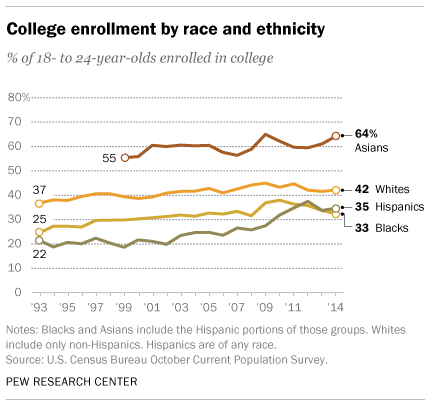
Also in the good news column, the University of California will continue to push for a greater number of underrepresented minorities; namely, Chicano/Latino students whose resident freshmen numbers rose from 2.7% to 32.3% of admitted California freshmen. In other good news, the proportion of Chicano/Latino students transferring from community colleges increased to 29.3% from 26.8% for 2015.
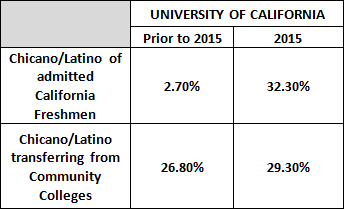
Occupations, including those in management, business, science, and art, fared better for Mexican Americans. The number of Mexican Americans filling these occupations rose from 17.4% in 2014 to 17.5% in 2015.

The total number of Hispanics filling these occupations was 16.1% in 2015, a bit lower than Mexican Americans specifically.
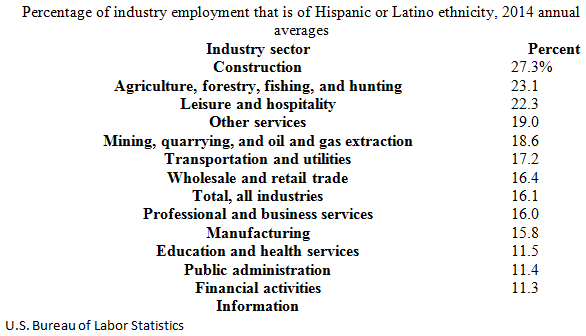
The report shows that industrial employment for Mexican Americans remained the same for 2014 and 2015 at 10.2%.
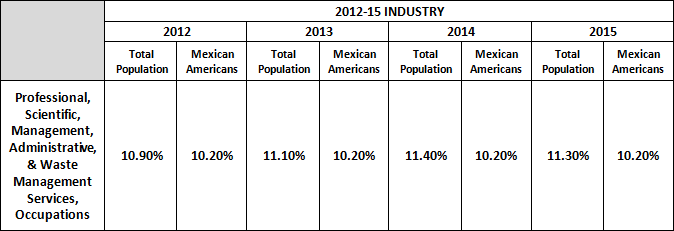
The figures for Hispanic or Latino employment for 2015 and 2016 show a healthy increase.
According to the Pew Hispanic center, “Construction, professional and business services, health services, financial services and food services…showed healthy gains.” Most of the jobs gained by native-born Hispanic workers were in manufacturing, mostly durable goods (82,000 Hispanic workers in this industry), followed by wholesale and retail trade (79,000), publishing, broadcasting, communication and information services (55,000), and construction (54,000).
Foreign-born Hispanics had the most job gains in construction (417,000), followed by business and professional services (179,000). Together, those two industries accounted for almost three-quarters (74%) of all jobs gained by foreign-born Latinos between 2005 and 2006.
The business and professional services sector, which ranges from management and technical services to janitorial, landscaping, and waste management services, is also a key employer for non-Hispanic workers. Of the total increase in employment in 2005-06, non-Hispanic workers accounted for 410,000 employees in the industry, native-born workers 327,000, and foreign-born workers 83,000.
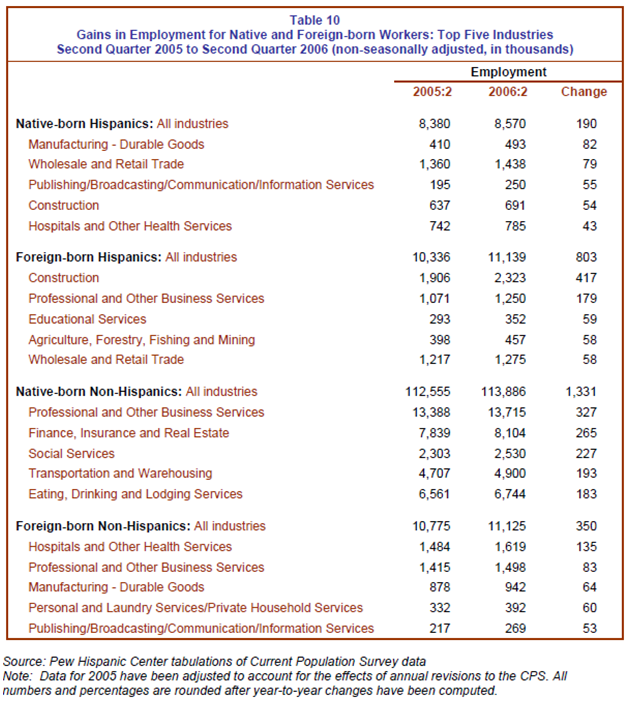
Sources
- Census Bureau, Selected Population Profile in the United States: 2015
- Pew Research Center
- University of California
- Bureau of Labor Statistics
Obama White House Touts Latino Gains in Income, Education, Health
by SUZANNE GAMBOA
WASHINGTON, DC — The White House on Wednesday touted gains Hispanics have made in education, income and health insurance during President Barack Obama’s time in office.
In a report released to mark the closing days of Hispanic Heritage Month, which ends Saturday, the White House issued a four-page brief from its Council on Economic Advisers on the Hispanics’ economic progress in the Obama years.
Obama marked the close of Hispanic Heritage month with remarks at a White House reception Wednesday afternoon. Hispanic Heritage Month began Sept. 15 and closes on Saturday.
“Over the last eight years we have made a lot of progress, together for all Americans and nowhere have you been able to see more vividly the progress than in the Hispanic American community,” Obama said at the event…
Link to article
USC professor spotlights the significance of Latinos to California’s future
The USC Price School of Public Policy has taken a leading role in training local decision-makers and its partnership with the Latino Caucus demonstrates the inroads it has made.
That’s a thought from USC Price Professor Raphael Bostic.
USC Price hosted more than 20 public officials from the League of California Cities Latino Caucus, who took part in the Bedrosian Center on Governance’s Local Leaders Executive Education Forum on Sept. 22 and 23.
The participants, many of whom are mayors or council members of cities across California, heard presentations from USC Price faculty on leadership, public ethics and housing policy, among other topics.
Professor Frank Zerunyan, director of executive education at the Bedrosian Center, led the program, which was the product of an agreement that USC Price and the Bedrosian Center signed with the Latino Caucus in 2014 to provide training aimed at enhancing the leadership capacity of public officials statewide…
Link to article
Hispanic millennials make less, but save more
Most millennials are trying to save for retirement, but female and Hispanic millennials make less money than their counterparts and are more focused on everyday finances, according to new survey results released Wednesday by Wells Fargo.
The survey focused on how millennials plan for retirement. A $1-million savings goal is supposed to provide enough retirement funds for decades, according to Wells Fargo. While 64 percent of respondents said they don’t think they will ever save enough to hit that mark, nearly 60 percent have started stashing away money anyway…
Link to article
Is Acculturation Really Dead?
We’ve been hearing the death knell for acculturation for the past several years now in the Hispanic marketing world. A large percentage of Fortune 1000 companies, however, still use acculturation as a point of reference for segmentation so as a research company we still see acculturation models regularly.However, a call with an ad agency last week made us do a double take and question, is acculturation really dead? We were discussing a research strategy and mentioned segmenting by acculturation for research purposes and we were stopped dead in our tracks by the statement, “Let me stop you there. All Hispanics are bicultural. All Hispanics speak English. Acculturation is an outdated concept.” …
Link to article
NALEO Educational Fund Board Member Rick Olivarez Joins Master Your Card Latino Advisory Board Read more: http://www.benzinga.com/pressreleases/16/05/p8052813/naleo-educational-fund-board-member-rick-olivarez-joins-master card Latino Advisory Council
Olivarez to work with Master Your Card: Oportunidad to help Latinos realize greater financial inclusion and growth
WASHINGTON, D.C. (PRWEB) May 31, 2016
Master Your Card: Oportunidad, a community empowerment program sponsored by MasterCard®, today announced that Rick Olivarez, National Association of Latino Elected and Appointed Officials (NALEO) Educational Fund board member, joined the program’s advisory board.
“Rick Olivarez and generations of his family, including his grandfather who founded NALEO, have been committed to advancing the Latino community,” said Fabián Nuñez, former speaker of the California Assembly and chair of the Master Your Card: Oportunidad Advisory Board. “The Board consists of nationally recognized Latino leaders who…
Link to article
Why is There No Room for Hispanics On Corporate Boards?
For the seventh consecutive year, the percent of directors of Hispanic origin elected to Fortune 500 boards was sharply lower than the overall representation of Hispanics in the U.S. population, according to the Heidrick & Struggles 2016 board monitor.
Of 399 new directors appointed by Fortune 500 companies in 2015, only 16 were Hispanic — a measly four percent. Over the past seven years, an average of 4.7 percent of new directors have been Hispanic. That dire statistic reveals there has been no discernible upward trend. Nothing. As the Hispanic share of the U.S. population has grown during those years, the gap of under-representation in the boardroom has therefore widened…
Link to article
Organization Advocates for More Latinos On Corporate Boards
WASHINGTON, DC — It is an absolute business imperative to have Latinos and Latinas in leadership positions in the business world, particularly on the boards of the country’s top companies, where the numbers remain dismally low. That was the focus of a recent gathering here of many of the nation’s business leaders to commemorate three decades of the Hispanic Association on Corporate Responsibility (HACR), an organization that advocates for a greater number of Hispanics in corporate America.
Just over 7 percent of Latinos hold board seats among Fortune 500 companies, and just 4 percent of all executive positions…
Link to article
8 Latino business founders breaking down barriers
Making their million-dollar mark
Latino-founded businesses are booming, yet less than 2 percent of Latino entrepreneurs ever make it past the $1 million revenue mark, according to the U.S. Census Bureau. Of the 1.4 million Latino-owned companies in the United States, the average has $156,000 in annual sales, revealed a study from the Latin Business Action Network (LBAN)…
Link to article
Why so few Latino-owned businesses get venture capital funding
In the world of venture capital, Latino-owned businesses are rarer than billion dollar unicorns.
Only about 1% of all Latino-owned businesses created between 2007 and 2012 in the U.S. received venture capital or angel investments, according to a report by the Stanford Graduate School of Business that surveyed roughly 1,800 businesses.
One big reason: Very few Latino-owned firms are even walking through the doors of venture capital firms to begin with…
Link to article
5 Reasons Brands Should Use Facebook Instant Articles To Engage With U.S. Hispanics
Last month, Facebook announced that on April 12, they will be “opening up the Instant Articles program to all publishers—of any size, anywhere in the world.” Yes, this means that brands can now leverage Facebook Instant Articles to engage with consumers.
Facebook created Instant Articles to optimize the experience for users who click from Facebook to a third-party publisher’s website on their mobile devices. For brands, Instant Articles not only optimize page load times, but can be leveraged to create more immersive experiences that are integrated with the all-important Facebook news feed…
Link to article
Community Voices: Latinas working to empower each other
When it comes to Latinas, it seems that all eyes are not only placed on women such as Jennifer Lopez, Selena Gomez or Sofia Vergara. Throughout the entire country, the number of Hispanic women is growing and so are organizations and companies that focus on the growth of Latinas…
Link to article
Job Opportunities for Latinos — Marketing Specialist
Information is the key to success these days especially in business. Most companies, entrepreneurs and organization are even willing to spend millions just to gather important details they can use to know more and understand their customers. That’s why jobs that are inclined to its niche, like Market Specialists, have a projected demand increase of about 41 percent from 2010 to 2020…
Link to article
From Undocumented to Goldman Sachs Exec: Julissa Arce’s Amazing Story
NEW YORK, NY — A job at the investment bank Goldman Sachs is one of the most prized positions in the country. The company prides itself on attracting some of America’s most talented professionals—ambitious, smart and highly motivated. Many people would probably be very surprised to discover that at least one undocumented Mexican immigrant was working shoulder to shoulder with the country’s corporate elite.
Former Goldman Sachs vice president Julissa Arce, 32, wants to change the way Americans think about immigration by sharing her story. And in her upcoming September 2016 memoir, “My (Underground) American Dream,” she aims to describe her long and difficult journey from undocumented to documented, which took her from selling funnel cakes in Texas to Wall Street…
Link to article
From the Delano Grape Strike to the Mexican American Vintners Association
By Humberto Gutierrez
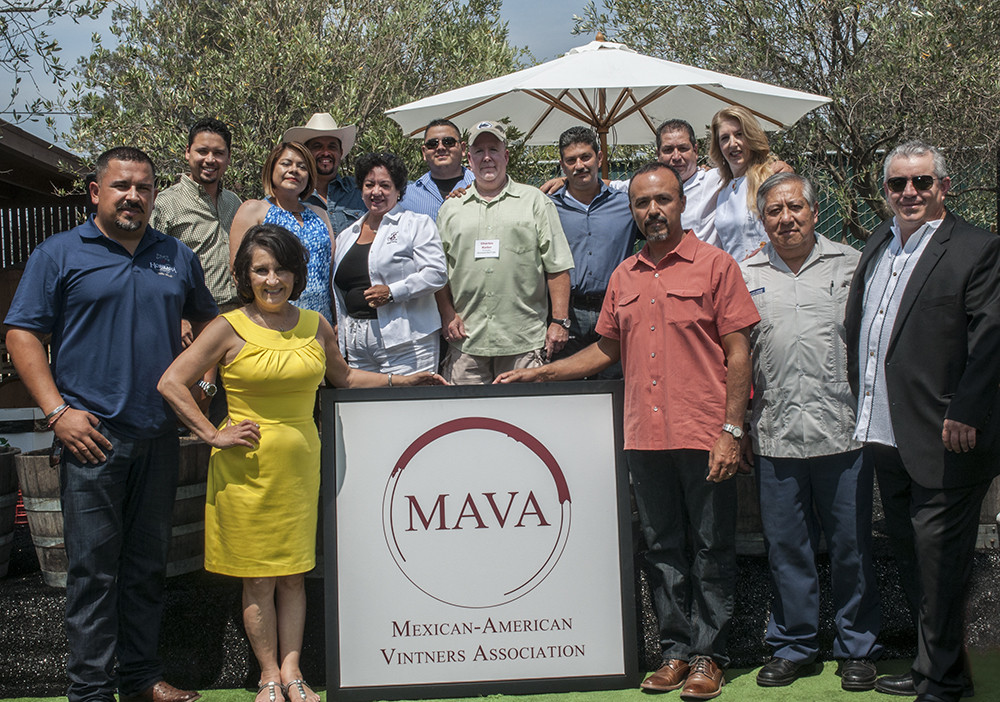
There have been several longitudinal studies on Mexican American mobility showing that although the monetary movement of Mexican Americans is not quite as rapid as that of whites, there is still a steady accumulation of wealth across generations.
This mobility is evidenced by the progress made by Mexican American professionals. As evidence of this success, we have witnessed the birth of several prominent professional associations. Most notable are:
- MAES, Latinos in Science and Engineering
- AMAE, Association of Mexican American Educators
- MABA, Mexican American Bar Association
- SACNAS, Society for Advancement of Chicanos and Native Americans in Science
- MAHPA, Mexican American Hispanic Physicians Association
- MABPA, Mexican American Business and Professional Association
- MALFA, Mexican American Latino Faculty Association
- MAVA, Mexican American Vintners Association
The latest American Community Survey shows year-to-year progress, or lack of it, on the survey’s annual census.
Prominent among this year is the continued progress of Mexican American college enrollment, which has jumped from 18.1% in 2013 to 18.7% in 2014. Unfortunately, graduate or professional degrees remain low with a small gain. For 2013, the graduate or professional degree was 11.2% and for 2014 this percentage climbed to 11.4% for the total population, while for 2013 it was 2.8% for Mexican Americans, and 2.9% for 2014.

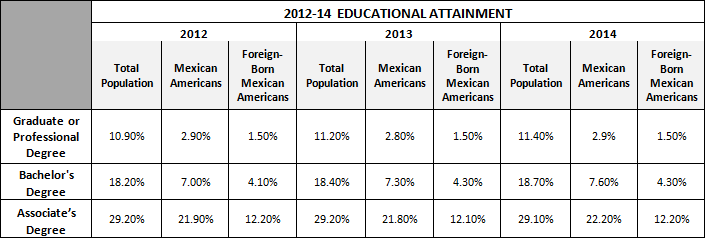
Occupations in management, business, science, and arts showed a nice increase for Mexican Americans, from 16.7% to 17.4% while for the total population percentages went from 36.3% in 2013 to 36.9% in 2014. Mexican Americans still lag far behind the total population but there is a slight gain as compared to the total population.

For industry, numbers have gone up slightly for the total population but have remained stagnant for Mexican Americans.
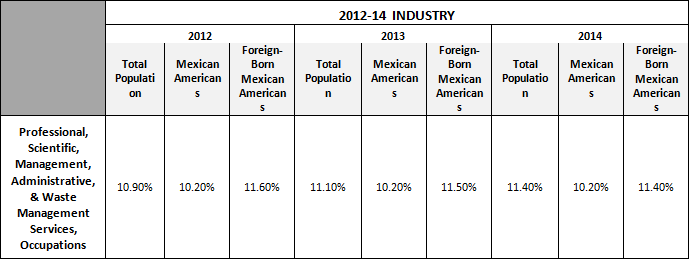
References
- Census Bureau, Selected Population Profile in the United States: 2014
- United States S0201 and B05006. Selected Population Profile in the United States
- Population Groups: Mexican and Mexico (foreign-born)
- Data Set: American Community Survey 1-Year Estimates for years 2012 and 2014
- Census Bureau, American Fact Finder, Selected Population Profile in the United States
Declining Ratings for Mexico’s Peña Nieto
Three years after being elected president, Mexico’s Enrique Peña Nieto is increasingly unpopular. Following a year plagued by scandal and controversy, his ratings have fallen, and Mexicans have grown disappointed with key elements of his ambitious agenda…
Link to article
A Comparatie Study of the Perceived Housing Needs of Low-income and Upper-Middle-income Residents of San Jose California
A Mazur – 2015
… B. Neighborhoods. IV. Mexican-Americans and the Elderly. A. Physical Structures. … While only
5’1 of the housing units occupied by non-Mexican-American whites were unsound in I960, 23′,
of the units occupied by Mexican-Americans were unsound. Overcrowding was …
Link to report


